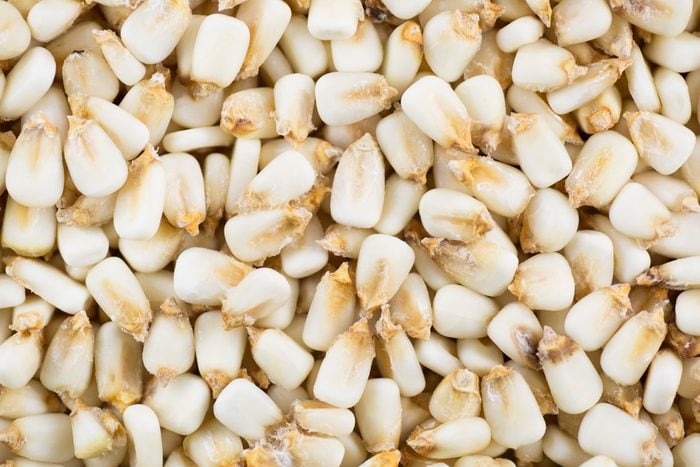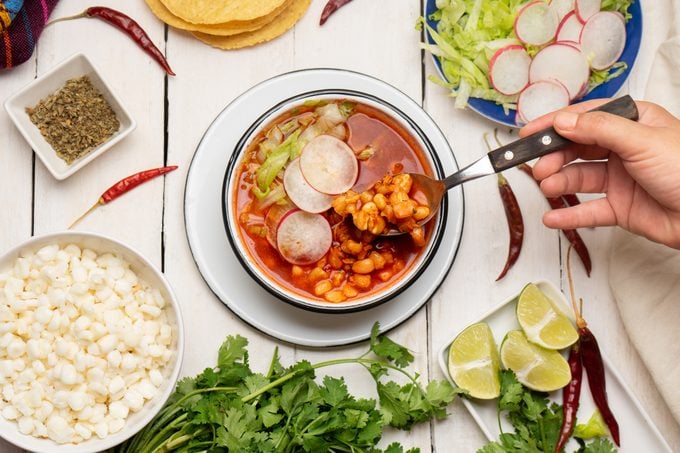What Is Hominy and How Do You Cook It
Updated: Jul. 12, 2023

All hominy is corn, but not all corn is hominy. We break it down and explain what hominy really is.
My early cooking days in college were largely characterized by food that came from the middle of the grocery store. I was on a budget, so I became a whiz at making Hamburger Helper and Rice-A-Roni taste like they didn’t come out of a box. One day, I came back from the store with what I thought was a can of corn. I opened the top and poured the contents into a bowl to make an easy corn and black bean salsa. The contents looked strange: The corn was large and chewy, and it wasn’t quite as sweet as corn. A quick look at the label revealed I had purchased hominy instead!
What Is Hominy?
Hominy comes from white or yellow field corn. Unlike sweet corn that’s eaten straight off the cob, field corn stays in the field until the ears dry. After the dried kernels are removed, the corn is used for livestock feed or turned into products for human consumption, like cornmeal, corn oil or corn syrup.
Another common use for field corn involves nixtamalization, a process that started in ancient Mesoamerica and gained popularity in the American South. Soaking corn kernels in lye or lime solutions plumps up the kernel while also removing the hull and germ, making the corn more digestible. The process also makes certain nutrients (specifically, niacin or vitamin B3) more absorbable in the body. As a bonus, the corn won’t sprout in storage like untreated corn.
When the nixtamalized corn is left whole, it’s called hominy. When ground, it is referred to as hominy grits or masa harina, a naturally gluten-free flour used to make tortillas, tamales and other Latin American dishes.
What Does Hominy Taste Like?
Hominy tastes a little bit like corn, but less sweet. It has an earthy edge and a nutty vibe. It’s significantly chewier than sweet corn, and it exhibits a softer, fluffier texture. There are two types of hominy—yellow hominy and white hominy. They taste pretty similar, although the yellow variety is the slightly sweeter of the two.
Corn vs. Hominy
The difference between corn and hominy are immediately apparent. Corn kernels are much smaller with an oblong shape and a slightly rounded tip. Hominy can range between one and two inches in length, and it has a more irregular, plump shape. It’s harder to tell the difference between the ground products. Cornmeal (made from ground corn) has a gritty texture, and it can range in size from fine to medium coarse. Masa harina is typically finely ground like flour, whereas hominy grits have a very coarse texture with granules that are larger and more irregular in size
Is Hominy Healthy?
Hominy is generally considered healthy. It’s a naturally gluten-free whole grain, and it’s a good source of essential nutrients and dietary fiber. It is low in fat compared to other starches, but this quality is largely affected by how it’s prepared. Adding excess amounts of butter, oil, salt or high-calorie toppings can increase the overall calorie and fat content of the dish.
How to Cook Hominy

There are three types of hominy: dried, frozen and canned. Dried hominy keeps in the pantry (like beans) and is best soaked overnight before simmering in water until tender. Frozen hominy is a popular choice for making New Mexico pozole, and it’s typically cooked in a pressure cooker or slow cooker.
Canned hominy is the easiest one to use. It’s already cooked, so you can use it directly without the need for soaking or extended cooking. Add it to stews, beef chili, soups or casseroles like our Holiday Hominy. It also works well in slow cooker dishes like this Spanish Hominy recipe.
